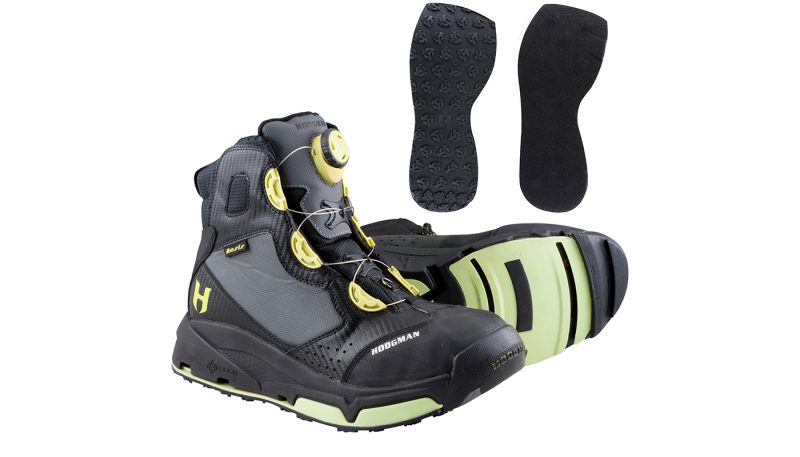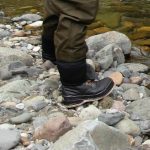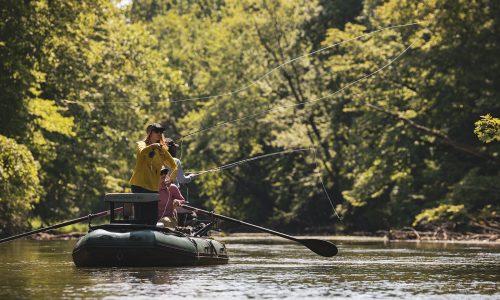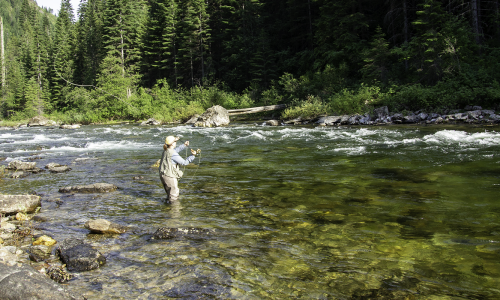Home » Gear Reviews » Fishing » Wading Boots » Men's Wading Boots » Hodgman Aesis H-Lock Wading Boot
Hodgman Aesis H-Lock Wading Boot Review
August 2, 2018









 79
79 The Good
- Highly versatile
- Great ankle and foot support
- Very Durable
The Bad
- Heavy
- Somewhat difficult to change soles
- Fit is overly wide in heel and forefoot
The Hodgman Aesis H-Lock Wading Boots offer a great option for anglers who venture into a wide variety of fishing environments. The stout, supportive uppers give great ankle protection in rough terrain, while the interchangeable outsoles provide solid traction options for everything from slick rocks in fast-moving rivers, to steep pebble slopes in tidal waters.
Fit
The Aesis H-Lock feature a generous cut to accommodate bulky neoprene wader booties, but we found the fit a bit too generous. The wide heel cup of the Aesis allowed a bit of heel slippage, especially when climbing steep river banks. The Boa lace system helped compensate for the loose heel by firmly tugging the foot back into the heel cup. But there was still a bit of slippage, especially side-to-side. Additionally, the wide forefoot allowed side-slippage in the toes and ball of the foot, putting foot stability at risk. That said, anglers with wide feet or those who wear extra thick waders (i.e. winter-weight neoprene waders), the Aesis might be the perfect solution for their fit issues.
Grip
With the option to change from thick felt soles to soft rubber, anglers have the ability to match their traction to their environment. Despite innovations in rubber compounds, there’s still no match for a dense felt sole when it comes to grip on slime-covered river rocks. The rubber soles offered by the Hodgman Aesis clearly lacks the grip of felt in those situations, but the rubber does perform well on the pebbly beaches of Puget Sound and the northern Pacific Coast. They also provide good traction riverside trails and approach routes when having to hike into fishing water — hiking in felt is like walking on ice. It can be done, but extreme care has to be taken.
The removable soles feature a curved track that clips into a rail system on the base of the boot then twists to lock into place.
Weight
With its tall shin-height upper and stout construction, the Hodgman Aesis H-Lock boot is heavy and feels even heavier thanks to the bulky design. Our test samples, size 13, tipped the scales at 1 lb, 15 ounces per boot with rubber soles in place. What’s more, the wide, overly voluminous boots tended to trap a lot of water, adding considerable weight when wet.
Treadlife
The Hodgman felt soles held up well over a few months of use, though the felt pad was considerably thinner than those found on the permanent felt soles of other brands’ boots – the Hodgman felt measured just over half the thickness of the felt commonly found on Korkers boots, for instance. The rubber soles, meanwhile, wore quickly. The lugs on the outer edges wore most rapidly, but the entire sole showed considerable wear after just a half-dozen uses.
Durability
The stout construction – the uppers feature triple-stitched panels – makes the boots a bit heavy, but also makes then strong and durable. We experienced no issues with the uppers after substantial use. But the H-Lock interchangeable sole system did present some issues. The system worked well when clean and dry, but once the boots had been worn through mud, sand, and gravel, some issues developed. Grit infiltrated the system and made removal and replacement difficult. A heavy flushing with clean water, and application of a stout brush allowed the system to operate. But the long-term durability of that system will depend on the amount of grit and debris that’s ground through the tracks and rails. The more frequently the soles are changed, the more the system is degraded.
We field tested the boots in a variety of conditions, from the pebbly beaches of Puget Sound while chasing Sea-Run Cutthroats, to the fast waters of the Salmon River in Idaho. We wore each pair of boots for multiple days, and wore mixed pairs on multiple occasions – that is, one model on our left foot, another on our right – to get direct side-by-side comparisons.
Dan Nelson
- Managing Editor & Fly Fishing EditorDan Nelson is GearInstitute.com's Managing Editor & fly fishing editor. He is based in the Pacific Northwest.




















No reviews have been posted for this product.
Use this gear?
Join Gear Nation and leave a review!
Create an Account